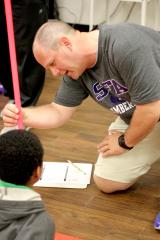
Stephen F. Austin State University kinesiology major Dana Henson measures trunk extensor strength and flexibility while administering the FitnessGram tests to students at Thomas J. Rusk Elementary School.
David Goodman, coordinator of undergraduate studies in SFA’s Department of Kinesiology and Health Science, said students in his measurement and evaluation course were able to bring their classroom knowledge into the real world when they administered the tests.
“By going to area schools, students get the opportunity to conduct fitness tests on individuals they do not know,” Goodman said. “While peer assessment is a valuable learning tool, being able to conduct testing on individuals they have never met is even better. This experience can help students confirm or possibly change their thoughts about working with or teaching physical education, physical skills and fitness development, especially in regard to young children.”
While preparing for the testing, SFA students learned proper techniques regarding how to perform the physical skills used to test the components of health-related fitness and the testing protocols for administering the FitnessGram tests, the most widely used youth health-related fitness assessment and education/reporting tool.
FitnessGram tests aerobic capacity, body composition, flexibility and muscular strength/endurance. In 2007, the state of Texas passed legislation mandating students in grades 3-12 have their fitness levels measured by FitnessGram.
“The students experience different methods for organizing, setting up and administering the tests while also learning verbal communication skills through explaining kinesiology-based terms and concepts to the public school students,” Goodman said. “All of these skills are important no matter what fitness tests are being administered and regardless of the age of the individuals being tested.”



